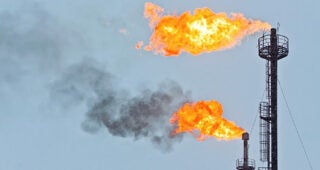- Resources
- Comprehensive climate reporting must include methane: New report shows you how
Resources
Comprehensive climate reporting must include methane: New report shows you how
Published: October 18, 2018 by Sean Wright
Just last month 13 of the world’s largest oil and gas majors—including ExxonMobil, BP and Shell —came together for a new commitment to reducing a key super pollutant. Methane, the primary component of natural gas, is the second leading contributor to climate change and over 80 times more potent than carbon when leaked into the atmosphere in the short-term. What’s more surprising? The coalition’s new methane target proceeded despite an uncertain regulatory landscape in the U.S.
One of 76 recent environmental rollbacks, the Trump administration’s latest move toward undoing common-sense methane regulations is expected by the EPA’s own estimates to allow an additional 480,000 tons of methane emissions. Yet behind the scenes, pressure on industry to transparently reduce emissions is coming from an unexpected source: investors. Investors understand the material risk methane poses their portfolios and have been urging companies to act. Given the lack of current national policy leadership in the U.S., investor pressure on industry to manage climate risks like methane will likely only increase.
But investor decision-making around climate issues like methane can only be as good as the information they receive from companies. Mark Carney and Michael Bloomberg, with the support of the Financial Stability Board, set out to tackle this problem. They formed the Task Force on Climate-related Financial Disclosures (TCFD) in 2015 and worked with industry, auditors and investors to write recommendations for consistent and comparable climate-related financial reporting. These recommendations are now supported by over 500 organizations, including mainstream investors like BlackRock and Legal & General, along with major oil and gas companies like BHP, Equinor, Eni, Shell, Suncor and Total.
However, the TCFD recommendations provide only high-level guidance for climate-related reporting for all sectors, meaning details for industry-specific implementation remain a challenge.
Methane is uniquely both a product and pollutant, which means these emissions represent a material risk as well as an opportunity for the oil and gas industry. Investors have found current methane reporting inadequate compared to its importance in determining the role gas can play in a low-carbon future. The inconsistency and inaccessibility of information leaves concerned investors in the dark about industry’s plan to manage a major climate risk. Adoption of the TCFD reporting principles in the oil and gas industry is essential for the planet and smart business.

A new joint report from Ceres, EDF and Principles for Responsible Investment (PRI), Setting the Bar: Implementing the TCFD Recommendations for Oil and Gas Methane Disclosure, takes the high-level TCFD recommendations, and puts them into discrete questions and metrics for companies to answer, and investors to analyze. Written with input from investors such as Vanguard and Hermes, the report is designed to help companies navigate the implementation of the recommendations by providing guidance on what kinds of information investors are looking for in each of the TCFD’s four categories: governance, strategy, risk management, and metrics and targets.

For example, the report asks questions, such as the following, for which companies should provide answers:
- How is methane incorporated into the board’s overall climate strategy?
- Within the past year, how many times has methane been on the agenda of the board and/or board committees?
- Has the company undertaken a formal materiality analysis for methane emission risk? If so, what were the results?
- Does the company have a methane reduction target?
Aligned with the TCFD’s high-level goals, the report aims to make information both consistent and comparable. Using these recommendations, companies will be able to better communicate how they are managing this material risk. With better information, investors will be able to make more informed decisions.
Over time, the top industry performers on material issues like methane management can stand out an increasingly competitive and cleaner energy future. As noted by USD 285 billion Dutch investor Robeco in the foreword to the report, “As investors tilt portfolios towards more sustainable companies, oil and gas companies who proactively and transparently manage methane will be better positioned to compete in a low carbon world.”
Follow Kate and Sean on Twitter, @Kate_Gaumond and @seantwright23
For more information on EDF’s investor resources on methane mitigation, please see our recent reports, Disclosure Divide: Revisiting Rising Risk and Methane Reporting in the U.S. Oil and Gas Industry, An Investor’s Guide to Methane, or subscribe to our newsletter.
